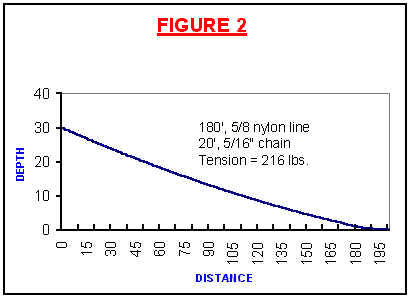An anchor rope is not just a straight link between the bow and the anchor. If you could swim down alongside it, you would see it start from the bow at a fairly steep angle, then slowly flatten out until it blends smoothly into the bottom. This curvature (mathematicians call it a "catenary") is due to the weight of the rope, which causes the line to sag. Having a lot of sag in the rope reduces shock loads and helps keep the anchor dug in by reducing the angle between the rope and anchor. The best you can do is an angle of "zero", which exists when the anchor rope is flat on the bottom, and all the pulling forces are horizontal. As tension increases, it reaches a point where the weight of the rope is overcome, and the angle becomes positive. Positive angles make the anchor work harder at keeping set, since the rope is now pulling up on the anchor. If the tension continues to increase, the catenary reduces to a straight line, and eventually the anchor pulls out.

Figure 1 shows the curved shape of a typical 200 foot, 5/8" diameter, nylon anchor rope in 30 feet of water. Using the equations for the shape of a catenary (see box), the maximum rope tension, 84 pounds, can be calculated. This is the most you can pull before the end of the rope lifts off the bottom and begins to apply a vertical, pull out, force on the anchor. Sailors are always interested in reducing the chance of an anchor dragging or pulling out. The most important factors determining pull out tension are anchor size, anchor type, and scope. The details of these factors have been be discussed for years (without resolution), however almost everyone agrees that anchor size depends on how big your boat is, the type is selected depending on where you plan to anchor, and more scope is always better. In crowded anchorage's, increasing scope is not always an option. Fortunately, several techniques are available that reduce pullout by increasing the maximum horizontal rope tension.

The most common approach is to add 20 feet of chain to the nylon rope. The additional weight of the chain holds the end of the rope down, which increases the maximum tension. This case is shown in Figure 2. The effect of adding 20 feet of chain is dramatic. The maximum tension, 216 pounds, is more than two and a half times greater than an all nylon rope. Of course, the chain also provides chafe protection to the nylon rope, which is very important around coral and rocks.

Adding a "Kellet" is another way to introduce sag into the rope and increase the horizontal tension. A Kellet is simply a lead weight that is attached somewhere along the rope. Letting the Kellet drop all the way to the chain gives the most increase in tension, but many sailors prefer a half way point, under the theory that it helps absorb shock loads better. The effects of a 20 pound Kellet, placed at 100 feet, is shown in Figure 3. The inflection point at 100 feet is clearly evident, and the maximum tension increases to 280 pounds, over three times more than the original all nylon rope.

This is about the end of "rope" for improving a nylon based anchor system. If you want a system that can develop more horizontal tension, about the only option left is an all chain rope. Figure 4 shows the all chain option. Going from nylon to chain increases the tension to 648 pounds, over eight times more than nylon. This is clearly one of the main reasons for going to an all chain rope. Kellets will also work with all chain ropes, however they only improve the tension slightly, unless they are extremely heavy.
Using these techniques to increase rope sag and improve anchor performance is only one factor in keeping your boat anchored. Adding a kellet or some chain won’t compensate for a fouled anchor, inadequate scope, failing to set the anchor properly, or using the wrong size or type of anchor. However, if you understanding the importance of rope sag and apply it to your anchor system, it will improve the holding power of whatever system you chose, and maybe even let you sleep a little easier when anchored in your favorite cove.